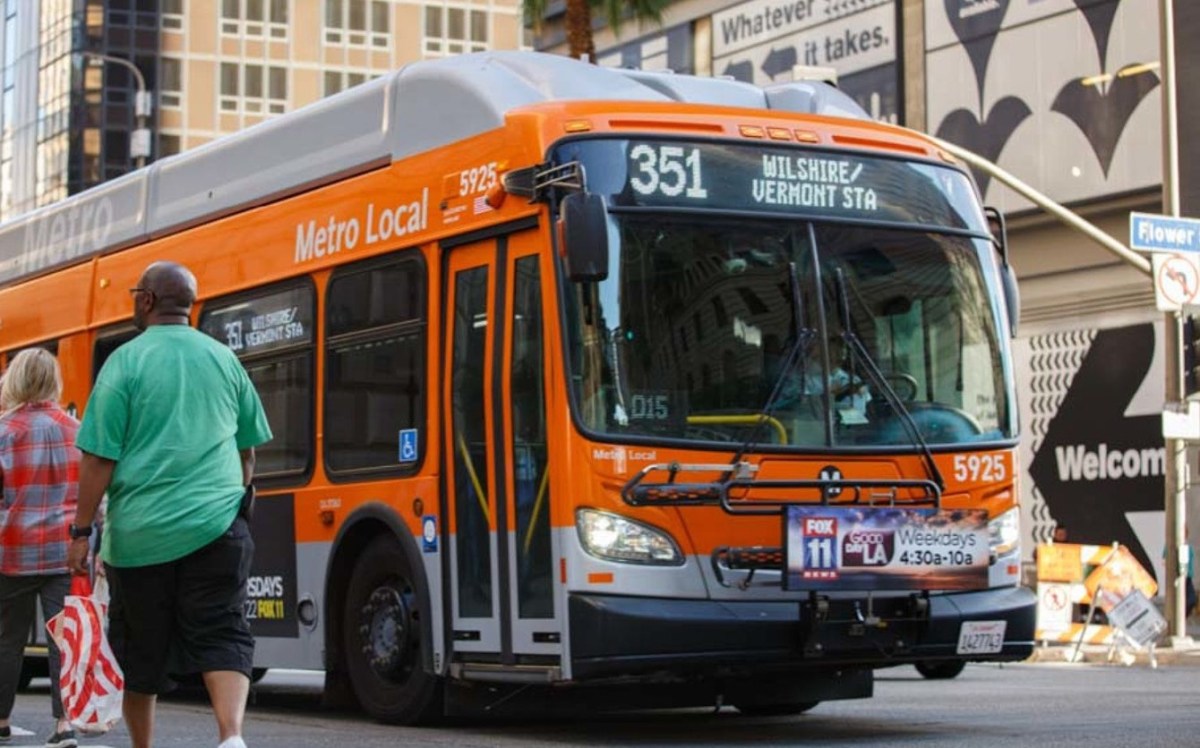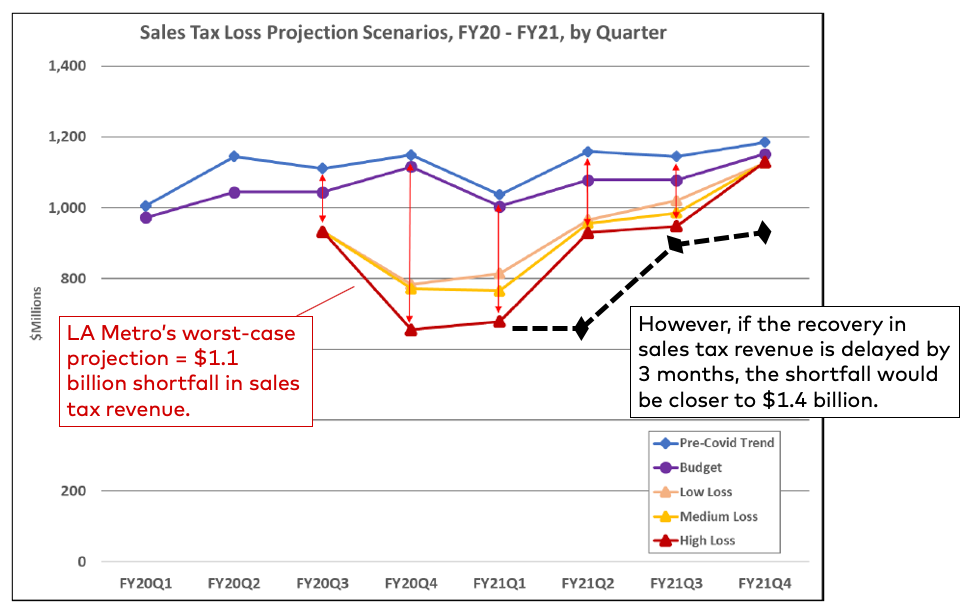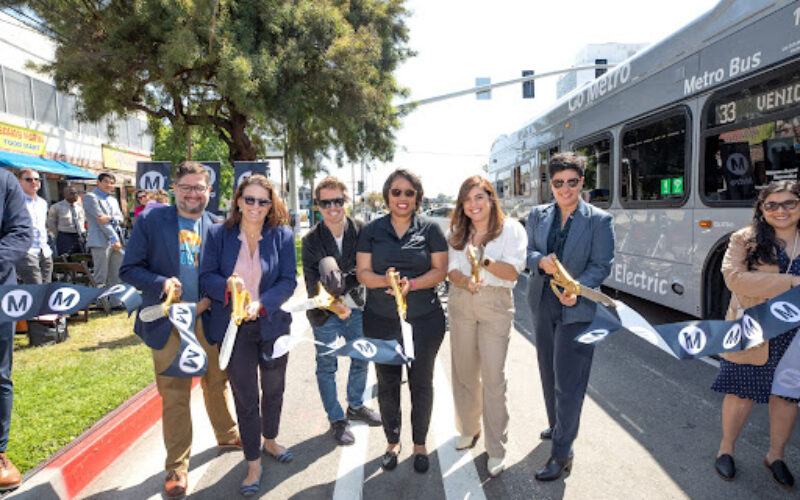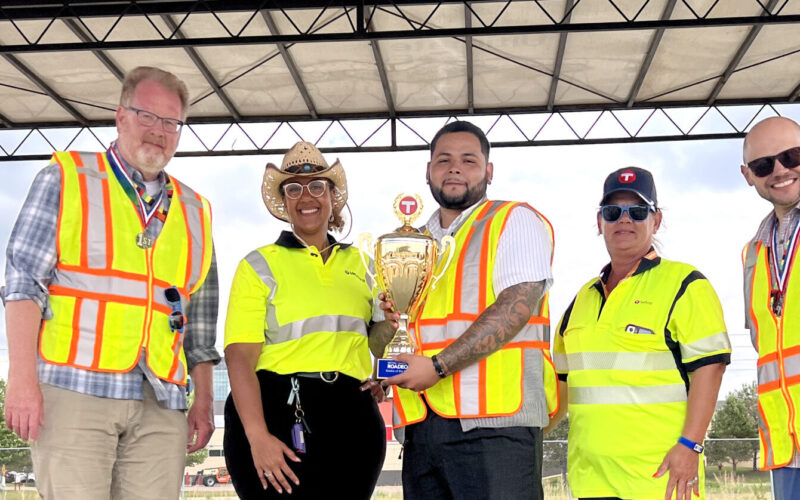
In the turmoil of the COVID-19 pandemic, Los Angeles Metro is scrambling to keep its major expansion projects on course for the 2028 Olympics. At the same time, the agency has been cagey about implementing its redesigned bus network, known as NextGen, and has proposed delaying pedestrian improvements that would address some of the fundamental problems faced by transit riders in LA.
When money is tight for transit agencies, the need to prioritize is even greater. For LA Metro, prioritizing what transit riders need would entail turning away from highway projects (which Metro funds) and rail projects in outlying areas, and toward investments that serve the many essential workers who continue to walk and rely on transit.
Metro’s Financial Situation Could Be More Dire Than Forecast
At its May board meeting, Metro staff warned that the agency faces an $800 million shortfall through June 2021. That’s based on a projected shortfall of $1.8 billion due to foregone fare revenue and–especially–declines in the sales tax revenues that represent the majority of the agency’s funding, with $1 billion in relief from the CARES Act softening the blow.
But the financial situation could be even worse than Metro projects. In May, staff presented a forecast suggesting that the region had already reached its economic rock bottom, and sales tax revenues would begin to recover in July. Since then, coronavirus cases have reached new highs in Los Angeles County, laid-off workers have lost their $600/week supplemental unemployment insurance benefit due to the Congressional impasse, and California officials are mulling a return to lockdown.
If the economic recovery is delayed by a quarter–if summer looks like the spring that Metro suffered through, in other words–then the true shortfall could be more than $300 million larger:

TransitCenter annotation of graph from LA Metro May 2020 board presentation.
What Are Metro’s Priorities?
In May, Metro CEO Phil Washington announced that cash management would require the agency to separate its projects into two “buckets,” the first consisting of projects that would move forward, and the second including projects that could be deferred, initially for 3-6 months.
The projects selected to continue are largely those that were under contract when the pandemic reached Los Angeles. The list varies wildly, from rail improvements in transit-supportive areas (like the Purple Line Extension and Regional Connector), to peripheral projects like an LAX airport connector, the extension of the light-rail Gold Line through the sprawling Foothills, and carpool lanes on I-5.
Projects in the bucket to be deferred also run the gamut, including both highway and transit expansion projects. Dismayingly, however, the delays will affect crucial priorities like state of good repair work on rail and bus facilities, as well as a much-needed “first/last mile” program to help local governments improve the state of pedestrian and bicycle access to Metro’s transit system.
There is no clear strategy to prioritize the essential workers who are most likely to walk to and ride Metro today. Rather, Metro appears most highly motivated to stick to its previous construction schedule in preparation for the Olympics. In remarks to the press, Washington has continued to emphasize his goal of getting “28 major transportation infrastructure projects completed in time for the [2028] Olympics.”
The advocacy group Investing in Place has warned that the future is unclear for NextGen, Metro’s proposal to redesign its bus network in ways that would bring frequent transit within walking distance of a million additional riders on weekdays. NextGen is perhaps the most important transit project in the region, yet it does not appear in either of Metro’s “buckets.”
Prospects for better bus service may be hard to discern until Metro releases a draft budget later this summer. As the state locked down, Metro switched to a Sunday schedule that represented a 29% reduction in bus service and 14% reduction in rail service from a typical weekday. It has gradually added some service back–but when will service levels return to pre-pandemic levels? Or, will Metro propose a shrunken transit system as a post-pandemic “new normal”?
The questions facing LA Metro today are not simply about staying afloat financially. With potentially years of economic pain ahead for the working-class riders who rely on Metro, will the agency prioritize overdue bus improvements that would greatly expand affordable mobility, or chase highway expansions and Olympic megaprojects?
 LA is (Not-So) Quietly Adding a LOT of Bus Lanes
LA is (Not-So) Quietly Adding a LOT of Bus Lanes
Thanks to the persistent work of local transit advocates, LA Metro is laying down 30 miles of bus lanes in 2023, pushing the total number of bus lanes in LA County to 40 miles.
Read More New TransitCenter Report: To Solve Workforce Challenges Once and For All, Transit Agencies Must Put People First
New TransitCenter Report: To Solve Workforce Challenges Once and For All, Transit Agencies Must Put People First
TransitCenter’s new report, “People First” examines the current challenges facing public sector human resources that limit hiring and retention, and outlines potential solutions to rethink this critical agency function.
Read More